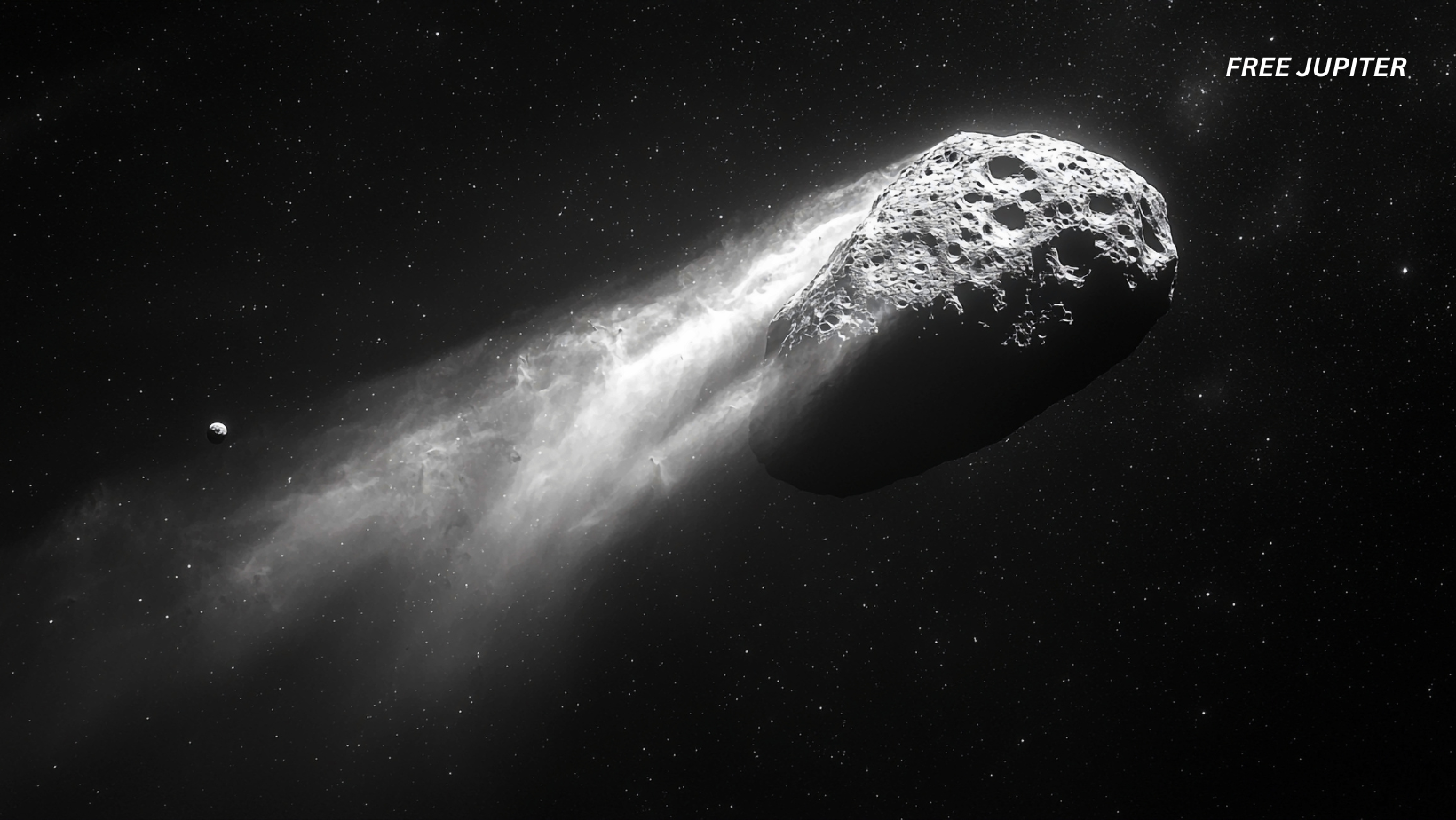Note: FreeJupiter.com shares general info for curious minds 🌟 Please fact-check all claims—and always check health matters with a professional 💙
What if you could hold something in your hand that existed long before the sun was born? Thanks to a daring NASA mission, scientists are now doing exactly that. Tiny specks of ancient stardust, carried back from the near-Earth asteroid Bennu, have revealed secrets not just of our solar system’s formation, but of interstellar space itself.
The findings, recently published in three major scientific papers, show that Bennu is far more than a simple rock drifting through space. It is a cosmic archive, holding organic molecules, icy minerals, and stardust older than the planets — all locked inside a body that has survived countless cosmic collisions and reshaping events.
These discoveries are reshaping our understanding of how asteroids form, how water and organic materials travel through space, and how life may have found its beginnings here on Earth.
NASA’s Treasure Hunt in Space
The story begins with NASA’s OSIRIS-REx mission, a spacecraft launched in 2016 with a bold goal: rendezvous with Bennu, collect a sample of its surface material, and return it safely to Earth.
Bennu was chosen for several reasons. First, it’s a near-Earth asteroid, meaning it passes close enough to our planet to make it reachable with current spacecraft technology. Second, its orbit makes it a “potentially hazardous asteroid” — while it isn’t expected to collide with Earth anytime soon, its trajectory does cross our planet’s orbital path, making it worth keeping an eye on. Finally, Bennu belongs to a class of asteroids rich in carbon and other complex materials, making it an excellent candidate for learning more about the raw ingredients of planets and life.
After a two-year journey, OSIRIS-REx arrived at Bennu in 2018. What it found surprised scientists: Bennu was covered in boulders, rubble, and shifting terrain. Its surface wasn’t smooth, but instead looked like a cosmic junkyard. Despite these challenges, the spacecraft performed a daring “touch-and-go” maneuver in October 2020, briefly landing and kicking up a cloud of dust and rock that it captured for return to Earth.
Three years later, in September 2023, the spacecraft released a capsule containing the samples, which parachuted into the Utah desert. Scientists have been eagerly studying the material ever since — and the results have been nothing short of astonishing.
Read more: James Webb Just Found a Brand-New Type of Climate on Pluto—Unlike Anything We’ve Seen Before
Stardust From Before the Solar System
The first set of findings, published in Nature Astronomy, showed that Bennu’s dust contains grains of stardust older than our solar system. These tiny particles formed in the violent deaths of ancient stars and drifted through space for eons before becoming part of Bennu’s parent asteroid.
To identify these ancient grains, scientists studied isotopes — variations of elements that carry distinct chemical signatures. Some isotopes matched what’s typically found in our solar system, while others had fingerprints that could only have come from interstellar space.
This means Bennu is a kind of “mix tape” of cosmic environments: it holds material from near the sun, from the outer solar system, and even from beyond our solar system entirely.
Ann Nguyen, a planetary scientist at NASA’s Johnson Space Center, explained it this way: “All of these constituents were transported great distances to the region that Bennu’s parent asteroid formed.” In other words, Bennu carries within it pieces of many different cosmic neighborhoods.
A Violent Family History
But Bennu wasn’t always Bennu. According to the research, it’s a fragment of a larger asteroid that lived — and died — billions of years ago.
Jessica Barnes, a co-lead author from the University of Arizona, describes Bennu’s parent body as a world with a complicated past. Scientists think this larger asteroid formed in the cold outer reaches of the solar system, likely beyond Jupiter and Saturn. At some point, it collided with another object in a catastrophic event that shattered it into pieces.
Those fragments reassembled into smaller asteroids, one of which eventually became Bennu. And this may not have happened just once. It’s possible Bennu’s parent body was shattered and reformed multiple times, like a cosmic recycling process.
Today, Bennu is what remains: a 500-meter-wide pile of rubble, carrying the chemical and physical scars of its violent past.
Bennu vs. Ryugu: Cosmic Cousins With Different Stories
The second study, published in Nature Geoscience, compared Bennu’s samples to those from another asteroid: Ryugu, which was visited by Japan’s Hayabusa2 mission. Both asteroids are carbon-rich and come from similar regions of the early solar system. But despite their shared origins, their stories diverged.
Ryugu’s samples suggest it experienced less interaction with water, while Bennu’s materials clearly show the influence of liquid water in the past. In fact, around 80% of Bennu’s sample is made up of minerals that contain water.
How did that happen? Scientists think Bennu’s parent asteroid accumulated ice along with dust. When heat — perhaps from radioactive elements inside the asteroid or from the energy of impacts — warmed this ice, it melted. The resulting water reacted with the surrounding minerals, altering their composition.
As planetary scientist Tom Zega explained, “All it needed was a little bit of heat to melt the ice and cause liquids to react with solids.” This reaction essentially rewrote Bennu’s mineralogy, creating hydrated minerals that wouldn’t have existed otherwise.
This watery past makes Bennu especially fascinating, because it shows how icy material could have delivered water — and possibly life’s ingredients — to early Earth.
Read more: James Webb Confirms There’s Something Seriously Wrong With Our Understanding Of The Universe
Scarred by Micrometeorites and Solar Winds
The third paper, also published in Nature Geoscience, examined Bennu’s more recent history. Even today, Bennu isn’t left alone in space. It’s constantly being bombarded by micrometeorites — grains of dust and rock no bigger than sand. These tiny projectiles hit Bennu at incredible speeds, leaving behind craters, cracks, and even melted patches of rock.
This process, called “space weathering,” happens on many airless bodies, including the Moon. But what surprised researchers was how quickly Bennu’s surface changes compared to expectations.
They also found traces of solar wind imprinted in the samples. The solar wind — a constant stream of charged particles blasted out from the sun — leaves chemical fingerprints on exposed rock, slowly altering it over time.
Together, micrometeorite impacts and solar wind mean Bennu’s surface is a dynamic, changing landscape, not a frozen relic.
Why Bennu Matters to Earth
All of this cosmic detective work leads to a bigger question: Why should we care about an asteroid millions of miles away?
The answer lies in what Bennu represents. Asteroids are the leftover building blocks of planets. They’re like nature’s time capsules, preserving the chemistry of the early solar system. By studying Bennu, scientists can glimpse conditions from billions of years ago — conditions that eventually gave rise to Earth, oceans, and life itself.
Asteroids may even have been the delivery vehicles for the ingredients of life. If icy asteroids like Bennu crashed into the young Earth, they could have deposited water and organic molecules that later formed the foundation for biology.
As Purdue University professor Michelle Thompson put it: “Asteroids are relics of the early solar system. They’re like time capsules. We can use them to examine the origin of our solar system, and to open a window to the origin of life on Earth.”
A “Potentially Hazardous” Neighbor
Of course, Bennu isn’t just a scientific curiosity. Its orbit brings it uncomfortably close to Earth from time to time. In fact, it’s classified as a “potentially hazardous asteroid.” While the risk of impact is very low in the near future, scientists keep a close watch on its trajectory.
In the year 2182, Bennu has a small but real chance of colliding with Earth — about 1 in 2,700, according to NASA. That may sound scary, but it also means Bennu is an excellent candidate for studying planetary defense strategies. Missions like OSIRIS-REx don’t just teach us about the past; they also prepare us for the future.
Looking Ahead
OSIRIS-REx itself is not done. After dropping off Bennu’s samples, the spacecraft was renamed OSIRIS-APEX and is now on its way to study another asteroid, Apophis, which will make a very close approach to Earth in 2029.
Meanwhile, the samples from Bennu will keep scientists busy for decades. Every grain of dust and every tiny rock fragment holds new clues — not only about Bennu, but about the larger story of our cosmic origins.
Read more: Rogue Planets Floating in Deep Space May Be Forming Their Own Moons
A Cosmic Scrapbook
In the end, Bennu is more than a wandering rock. It’s a scrapbook of cosmic history, filled with stardust older than the sun, altered by ice and water, scarred by meteorite impacts, and marked by the breath of the solar wind.
Its story reminds us that our solar system was not built in isolation. It was shaped by material that traveled across immense distances, forged in the hearts of stars that lived and died long before the Earth existed.
By studying Bennu, scientists aren’t just learning about an asteroid. They’re uncovering the story of how worlds are made — and perhaps how life itself first began.
Image: Freepik.










